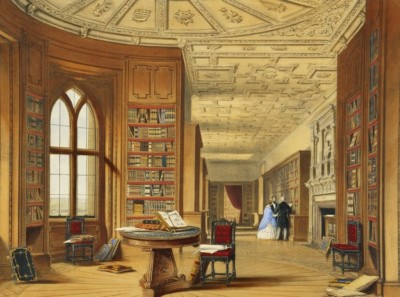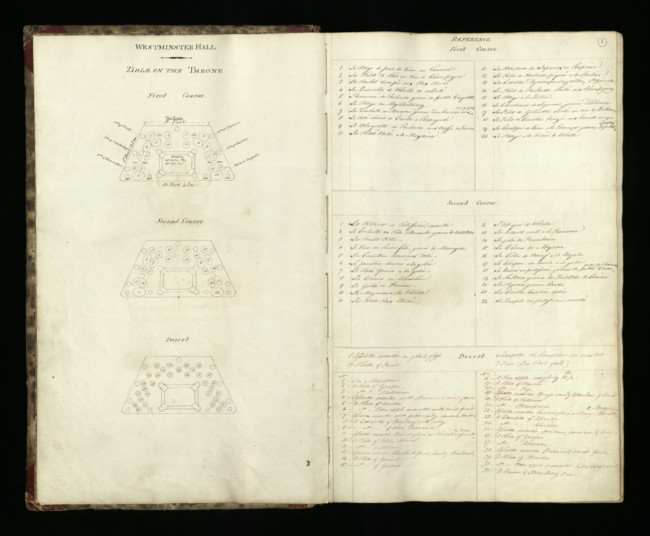Royal Collection Trust
Established in 1987, Royal Collection Trust is a department of the Royal Household and the only one that undertakes its activities without recourse to public funds. It incorporates a charity regulated by the Charity Commission and the Office of the Scottish Charity Regulator, The Royal Collection Trust, and its subsidiary trading company, Royal Collection Enterprises Limited.
Royal Collection Trust has over 400 staff and a Management Board of nine directors. It is responsible for the care of the Royal Collection, and manages the public opening of the official residences of Her Majesty The Queen and the official London residence of His Royal Highness The Prince of Wales.

The Library at Windsor, Joseph Nash. RCIN 817132.pl24. Royal Archives / © Her Majesty Queen Elizabeth II 2019
The Royal Library
The Royal Library is the official library of the Sovereign and is an incredibly diverse collection containing more than 200,000 items, including books and manuscripts, music and sound recordings, insignia, medals and coins.The most significant and substantial part of the collection of books and manuscripts is held in the Royal Library at Windsor Castle, created in the 1830s at the instigation of William IV. It occupies a suite of rooms on the north side of the Upper Ward, adjacent to the State Apartments.
The Royal Archives
The Royal Archives is the private archive of the royal family. It is a unique collection of documents relating to the history of the British Monarchy over the last 250 years. It includes the private papers of the royal family from 1914, as well as significant historic material, including the papers of George III, George IV, Queen Victoria and the exiled Stuarts.
The Royal Archives was first established in 1914 in the iconic Round Tower of Windsor Castle. The need for an archive for the papers of the royal family and the Royal Household had become evident only a few years earlier when in 1901 Queen Victoria left a legacy of a voluminous assortment of official and private correspondence. In addition to the collections of private and official papers of sovereigns and their families, the Royal Archives also holds records generated by the departments of the Royal Household and the private royal estates.
As the official repository for the documentary heritage of the monarchy, the Royal Library and Royal Archives support the work of The Queen and Royal Family, as well as the Royal Household and Royal Collection Trust.
The Royal Library, Royal Archives and the Georgian Papers Programme
A key aim for the Royal Library and Royal Archives is to facilitate access to the historic collections in their care. The Georgian Papers Programme (GPP) is a flagship project in this endeavour. It builds on the experience gained from other digital projects, which have seen the journals of Queen Victoria, as well as staff records for genealogical research, published online. It also stands alongside a further project with a commercial partner to digitise the papers of the William Augustus, Duke of Cumberland (1721–65) and those belonging to James II (1633–1701) and the exiled Stuarts. This means that by the end of 2020 the historic papers from the period before 1837 should all be publically accessible.
At the start of the GPP some key questions needed to be answered: What are the Georgian papers? How many are there? What information about them is already to hand? What condition are they in? An extensive scoping survey was conducted, which had several important results. Firstly, it became clear that the Georgian papers are largely unknown: they have not previously been catalogued and the substantial published editions by Fortescue and Aspinall only scratch the surface of the collection as a whole. Secondly, the Georgian papers are in fact not one, but many collections, each with a different provenance. Thirdly, this survey also revealed that the size of the task was much larger than originally anticipated, comprising an estimated 350,000 pages of material. A conservation survey was also carried out to assess both requirements to prepare material for scanning, and long-term preservation needs.
Other work was carried out to lay the foundations for work on the GPP. A new digitisation studio was commissioned to house two A1 scanners, one of which is equipped with a robotic cradle for handling large volumes. The Round Tower was also re-wired to handle the large amount of data generated by the scanning process. A further enhancement was the renovation of the office spaces, which allowed the research room to be moved to a better location, increasing its capacity and providing the space with modern furniture, a reference library and wireless internet.
Digitisation and cataloguing operations began in early 2016. The work to digitise the documents is conducted in the new studio within the Round Tower at Windsor Castle. A dedicated office provides workspace for the project team to catalogue the papers. The challenge is to make the papers discoverable for users while retaining the integrity of the historic arrangement, however complex that may have been.
A further important strand of work is conservation. It will be a valuable legacy of the GPP to put the preservation of the Georgian papers themselves on the best possible footing. The nature of the digitisation process means that each document can be assessed individually for its conservation needs and treated if necessary, before digitisation takes place. This work is done on-site in the Royal Archives’ conservation studio and in the Royal Bindery.

Extract from the Journal of Robert Fulke Greville. Volume 2, October 1788 – 4 March 1789, RCIN 1047014. Royal Archives / © Her Majesty Queen Elizabeth II 2019
The Royal Library and Royal Archives have also established the GPP online catalogue and microsite, which is hosted by Royal Collection Trust. These sites provide access to digitised material as it becomes available, as well as commentary and interpretation of the papers. Collaborative development with the other programme partners will aim to enrich and enhance the user experience of these resources.

Letter from Princesses Augusta, Elizabeth, Mary, Sophia, and Amelia to Lady Charlotte Finch, 18 October 1808 Royal Archives / © Her Majesty Queen Elizabeth II 2019
The Partnerships
Above and beyond this work, the Royal Library and Royal Archives are ambitious to create a more significant impact through partnerships with other institutions. These partnerships draw in a much broader network of expertise and help to multiply the impact of improving access to the papers, transforming the public and scholarly enjoyment of these historic documents.
Such collaboration creates opportunities for academics to research the papers. This not only contributes to our knowledge of the material, but also ensures that insights from this newly available documentation enter quickly into academic debate, teaching and public understanding. Given the foundational importance of George III’s reign for the history of the United States, it is especially pleasing to have prominent American members of the Programme partnership.
The partners also offer digital expertise, which helps ensure that the papers are presented in the best way to support the general public and academic researchers in finding documents of interest. The partnership thus provides avenues to pursue cutting edge developments in the transcription, indexing and analysis of documents. A key area to explore is the presentation of connections between documents and other artefacts in different collections, based upon different catalogue systems. This is important to help re-connect correspondence now in separate archives and is also invaluable to link the Georgian papers in the Royal Library and Royal Archives with art and furniture in the Royal Collection.


